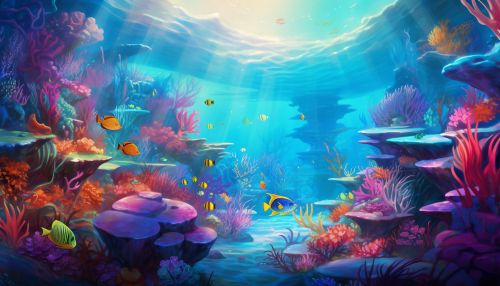Marine life
Introduction
Marine life, also known as marine biota, encompasses all the organisms that live in the ocean and other marine bodies of water. The diversity and abundance of marine life are vast, with a wide range of species, habitats, and ecosystems. Marine life is a critical component of the Earth's biosphere, playing a significant role in the regulation of the planet's climate and supporting a wide array of life processes.
Classification of Marine Life
Marine life is classified into various categories based on different factors such as taxonomy, habitat, and physiology. The primary divisions include the kingdoms of animals, plants, fungi, protists, and monera.
Marine Animals
Marine animals, or marine fauna, comprise a diverse group of species, ranging from tiny zooplankton to the largest animal on Earth, the blue whale. This category includes various subgroups like fish, mammals, birds, reptiles, and invertebrates.
Marine Plants
Marine plants, or marine flora, include species such as seaweeds, mangroves, and seagrasses. These organisms perform photosynthesis, converting sunlight into energy and producing oxygen, a vital process for life on Earth.
Marine Fungi
Marine fungi are a less-studied group of organisms that play a crucial role in nutrient cycling and decomposition processes in marine ecosystems.
Marine Protists
Marine protists are a diverse group of microorganisms that include both plant-like, photosynthetic species and animal-like, predatory species.
Marine Monera
Marine monera include the bacteria and archaea that inhabit the ocean. These microorganisms play a vital role in nutrient cycling and are essential for maintaining the health of marine ecosystems.


Marine Habitats
Marine habitats are as varied as the organisms that inhabit them. They range from the sunlit surface waters teeming with life to the dark, cold depths of the deep sea where extreme conditions prevail.
Coastal Habitats
Coastal habitats include areas such as estuaries, mangrove forests, coral reefs, and seagrass meadows. These habitats are often rich in biodiversity and are crucial for the life cycles of many marine species.
Open Ocean
The open ocean, or pelagic zone, is the largest habitat on Earth. It is home to a wide variety of species, from tiny plankton to large pelagic fish and mammals.
Deep Sea
The deep sea, or abyssal zone, is the deepest part of the ocean, reaching depths of over 6000 meters. Despite the harsh conditions, a surprising array of life forms have adapted to survive in this extreme environment.
Marine Ecosystems
Marine ecosystems are complex networks of interacting species and their physical environment. They include ecosystems such as coral reefs, kelp forests, and deep-sea vents, each with its unique set of species and ecological processes.
Coral Reefs
Coral reefs are one of the most diverse ecosystems on the planet, often referred to as the 'rainforests of the sea'. They are home to a multitude of species and provide important ecosystem services such as coastal protection and fisheries.
Kelp Forests
Kelp forests are underwater ecosystems dominated by large brown algae known as kelp. They provide habitat and food for a variety of marine species and play a crucial role in carbon sequestration.
Deep-Sea Vents
Deep-sea vents are unique ecosystems found at the bottom of the ocean. They are home to specially adapted species that rely on chemosynthesis, a process that uses chemicals rather than sunlight for energy.
Threats to Marine Life
Marine life faces numerous threats, including overfishing, pollution, habitat destruction, and climate change. These threats have led to declines in marine biodiversity and have significant implications for the health of the world's oceans.
Conservation of Marine Life
Efforts to conserve marine life include the establishment of marine protected areas, sustainable fishing practices, pollution control, and research to better understand marine ecosystems and the threats they face.
